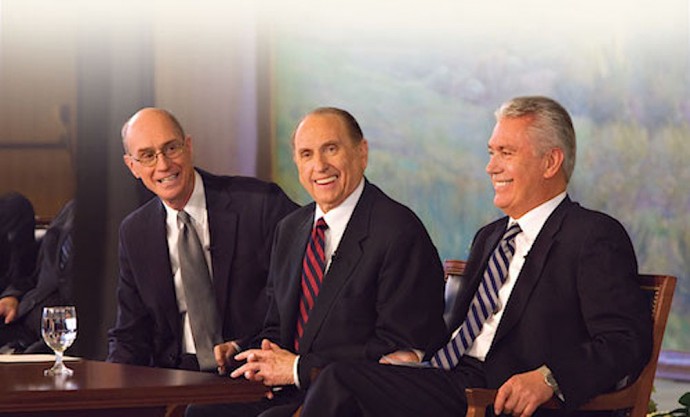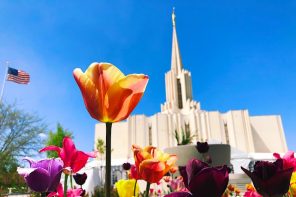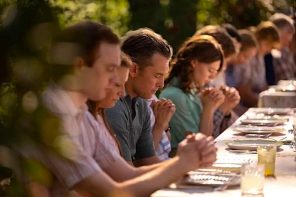News that the LDS Church has now publicly acknowledged founder Joseph Smith’s polygamous marriage to more than thirty women—one as young as fourteen years old—puts me in mind of a conversation I had one rainy September night with a bright and dedicated young Mormon woman at a feminist retreat in the woods of New Hampshire.
She was twenty-five years old, with a funky assymetrical haircut, a hipster plaid flannel shirt, and an aura of earnest intelligence and faithful dedication I could feel in my bones.
“I am the Relief Society president in my singles ward in Boston,” she told me, indicating her role as an appointed spiritual leader of a community of college-aged young women. “People are really struggling to make sense of all the problems in Mormon history and theology and to hang on in spite of them. What do I tell them?”
I wished in that moment—as I so often do—that these very real, very searching questions found greater support from the LDS Church leadership, instead of being left to independent historians, lay theologians, bloggers and podcasters, and the Facebook-zealous feminists, anti-racist activists, and LGBT allies of Mormonism’s progressive margins.
“Perhaps this is just the reality of who we are as twenty-first century Mormons,” I offered. “Perhaps being a twenty-first century Mormon means inheriting a tradition that is not exactly as we have been led to believe. What can it mean to be a people of broken stories? What can this teach us? And if we accept the brokenness of our faith, what can we continue to mean to each other?”
We stood together in the question, in the rainy dark, she and I. She nodded. We hugged. She disappeared into the evening.
How will the LDS Church’s new website on Joseph Smith’s polygamy—written by an unnamed and uncredited historian, released without announcement, invisible from the LDS Church’s landing page—help this devoted twenty-five year old Mormon woman guide and serve the people she is responsible for?
Her challenge, after all, is not that young Mormon people didn’t know that Joseph Smith was a polygamist. Of course, they already knew. Her problem is in helping young Mormon people come to terms with the way Joseph Smith was presented by Church curriculum as a virtually unflawed human being and the larger problem of how the LDS Church has tried to deny or manage our faith’s human problems and flaws.
The appearance of inerrancy
Of course, it’s not that Mormonism is the only religion to have such problems and flaws. It’s just the most recent, with the shortest elapsed time between its powerfully fabulous faith-commanding nineteenth-century origins and the critical examination of those original truth claims in light of competing historical and scientific evidences. Only Mormonism has had its human flaws captured so openly and thoroughly in the historical record.
This vulnerability has engendered avoidance and duplicity among LDS people who have felt obliged to defend the faith against debunking by outsiders.
In turn, this defensive posture found official support in the LDS Church’s twentieth-century implementation of “Priesthood Correlation,” a bureaucratic initiative that institutionalized Mormon history and theology in a predictable, consistent, and systematic way, giving it the appearance of essential coherence, timelessness, and inerrancy.
After correlation, there was virtually no room in institutional Mormonism to deal with the wrongness of historic and current Mormon teachings and practices—for example, the exclusion of men and women of Black African descent from priesthood ordination and full participation in LDS temple rites.
In the 1960s, LDS Church leaders threatened Mormon scholars, like the lay historian Lester Bush who painstakingly documented the roots of priesthood and temple segregation in the prejudices of individual LDS leaders like Brigham Young rather than in scripture or doctrine. Not until 2012—and then only after journalists focused on Romney’s campaign revealed the extent to which officially sanctioned racist theology persisted at Church-owned Brigham Young University—did the LDS Church issue an official acknowledgment that past or present racism was condemnable. To this day, even in a recently-released historical essay comparable to the Joseph Smith polygamy statement, the LDS Church has still not fully acknowledged that it was wrong to exclude faithful black men and women, nor has it apologized for its support of racial segregation.
Similarly, the new website on Joseph Smith’s polygamy does not say that Smith was wrong—not for marrying against the wishes of his first wife Emma, or marrying women already married to other men, or marrying girls as young as fourteen. It acknowledges that Smith’s polygamy demanded heartwrenching sacrifices of his first wife, but it sidesteps the crucial question of whether these sacrifices were founded in lasting principles of Mormon theology, or were they pains caused by the human excesses of our charismatic founder?
Is it the will of God that polygamy should persist in LDS Church theology and policies pertaining to LDS temple marriages, as it does to this day?
To this day, divorced or widowed men can marry a subsequent spouse “for eternity” in an LDS temple while divorced or widowed women cannot, a policy that suggests that in the eyes of the contemporary LDS Church polygamy is God’s intended order for the eternities. From the time I was a nine-year-old girl, I worried anxiously that I might be one of multiple wives in the eternities. The LDS Church has to this day given me and hundreds of thousands of other anxious Mormons no reason to believe otherwise. Not even in its new Joseph Smith website.
What if wrongness is holiness?
No, the problem for contemporary Mormons is not access to facts about the history of our faith. What’s missing is theological support for acknowledging that we have been wrong and that historical wrongs, flaws, and failures need rectification and reconciliation. Given its youth, Mormonism has a unique opportunity to explore powerful theological questions about the role of human error in the articulation of spiritual truth, the fallibility of religious leaders, and the responsibility of members to seek independent verification of truth and respectfully challenge untruth.
But it does not. Except in rare circumstances, it studiously avoids them. Continuing to avoid such questions and instead giving truth a carefully-managed bureaucratic roll-out, sustains a ground-level Mormon culture of rigidity and anxiety that will continue to make the faith difficult to inhabit for many Mormons. In its most extreme expressions, this rigidity and anxiety leads to contemptuous treatment of those who question and challenge in ways the bureaucracy cannot manage, as the June 2014 excommunication of women’s ordination advocate Kate Kelly reveals.
What does it mean that we have felt so powerfully about a faith that has sometimes been wrong? How do we understand the power, intimacy, majesty, pain, and disappointments of the lives we have lived as Mormons? What if wrongness is human, sanctifiable, and perhaps even a source of holiness? Is this not one of the most important stories Mormonism—or any faith that hopes to be relevant in the twenty-first century—can tell?
I hope the young Mormon feminist I met in the woods of New Hampshire on a rainy September night will be able to answer these questions in a way that the men in the bureaucratic LDS Church hierarchy seemingly cannot.





